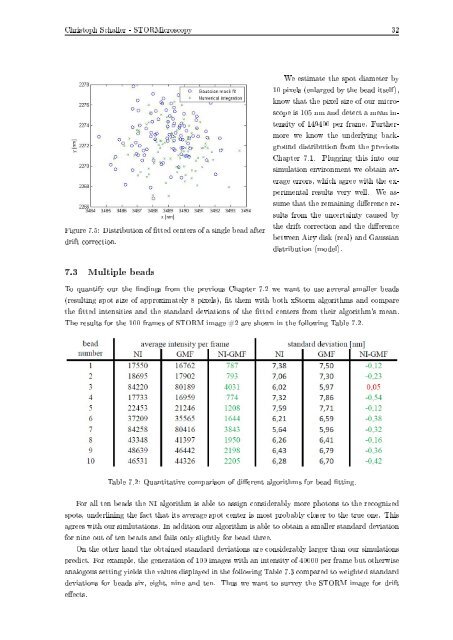Christoph Florian Schaller - FU Berlin, FB MI
Christoph Florian Schaller - FU Berlin, FB MI
Christoph Florian Schaller - FU Berlin, FB MI
Create successful ePaper yourself
Turn your PDF publications into a flip-book with our unique Google optimized e-Paper software.
<strong>Christoph</strong> <strong>Schaller</strong> - STORMicroscopy 32<br />
Figure 7.5: Distribution of tted centers of a single bead after<br />
drift correction.<br />
We estimate the spot diameter by<br />
10 pixels (enlarged by the bead itself),<br />
know that the pixel size of our microscope<br />
is 105 nm and detect a mean intensity<br />
of 149400 per frame. Furthermore<br />
we know the underlying background<br />
distribution from the previous<br />
Chapter 7.1. Plugging this into our<br />
simulation environment we obtain average<br />
errors, which agree with the experimental<br />
results very well. We assume<br />
that the remaining dierence results<br />
from the uncertainty caused by<br />
the drift correction and the dierence<br />
between Airy disk (real) and Gaussian<br />
distribution (model).<br />
7.3 Multiple beads<br />
To quantify our the ndings from the previous Chapter 7.2 we want to use several smaller beads<br />
(resulting spot size of approximately 8 pixels), t them with both xStorm algorithms and compare<br />
the tted intensities and the standard deviations of the tted centers from their algorithm's mean.<br />
The results for the 100 frames of STORM image #2 are shown in the following Table 7.2.<br />
Table 7.2: Quantitative comparison of dierent algorithms for bead tting.<br />
For all ten beads the NI algorithm is able to assign considerably more photons to the recognized<br />
spots, underlining the fact that its average spot center is most probably closer to the true one. This<br />
agrees with our simlutations. In addition our algorithm is able to obtain a smaller standard deviation<br />
for nine out of ten beads and fails only slightly for bead three.<br />
On the other hand the obtained standard deviations are considerably larger than our simulations<br />
predict. For example, the generation of 100 images with an intensity of 40000 per frame but otherwise<br />
analogous setting yields the values displayed in the following Table 7.3 compared to weighted standard<br />
deviations for beads six, eight, nine and ten. Thus we want to survey the STORM image for drift<br />
eects.









